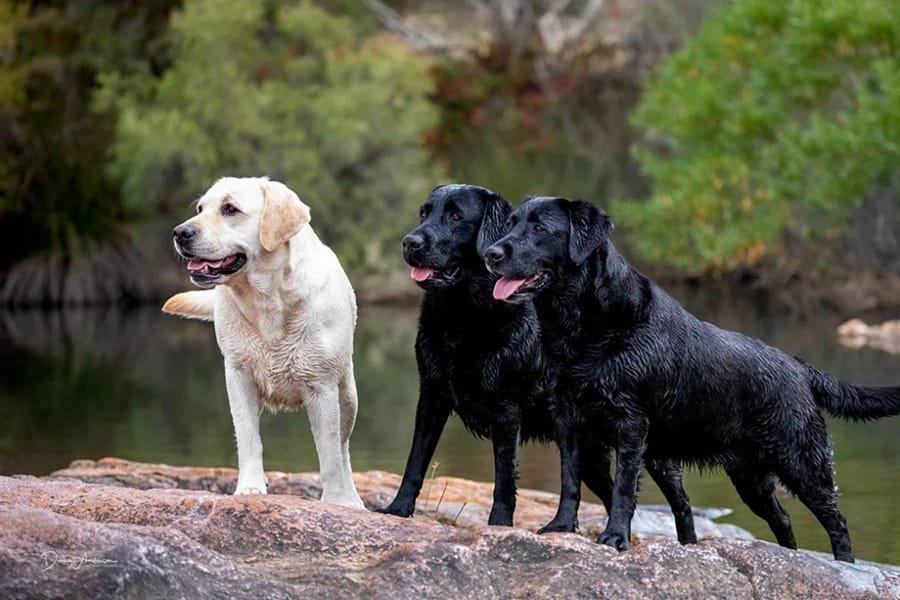Few dog breeds have obesity issues that evolve into a global concern—the Labrador Retriever is one of them.
As one of today’s most popular breeds, Labradors’ weight problems are a topic even scientists fret over.
Researchers at the University of Cambridge published a report in the journal Cell Metabolism, stating that a mutation in the POMC gene causes certain dog breeds, including Labradors, to become more food-obsessed and prone to obesity.
In other words, Labradors are genetically destined to be chubby.
But beyond their predisposition to weight gain, Labradors boast a host of unforgettable traits. If you read through this article patiently, you’ll discover a whole new side to the „Labra-chub“ (Labrador + chubby)!
Table of Contents
Basic Profile
Breed Name: Labrador Retriever
Size: Medium-sized breed
Energy Level: Highly energetic
Personality: Exceptionally intelligent, loyal, and tenacious
Affection Level: Extremely affectionate and clingy—a certified „Velcro dog“
Ability to Be Alone: Can tolerate solitude for short periods once mature
Trainability: Quick learner, highly trainable
Shedding Level: A walking dandelion (heavy shedder!)
Standard Weight: 25–36 kg
Standard Height: 54–57 cm
Common Coat Colors: Black, yellow, chocolate

Breed History
The Labrador originated on Newfoundland Island, Canada, descended from the now-extinct St. John’s Water Dog—a black, medium-sized hunting breed with white markings on the chest, paws, chin, and muzzle.
The St. John’s Water Dog came in two sizes. The larger ones were crossbred with Mastiffs, eventually evolving into the gentle giant Newfoundland Dog. The smaller, short-coated variants were used by local fishermen to retrieve codfish and nets in icy waters, becoming the ancestors of today’s Labrador Retriever.
Over time, the Newfoundland-type St. John’s Dogs were exported to England and Ireland. Meanwhile, the smaller ones stayed behind, aiding fishermen by retrieving nets and floating logs from rivers—a skill rooted in their knack for gripping buoyant objects with their soft mouths.
By the 18th century, some of these dogs arrived in Poole, England, via Newfoundland’s fishing trade. Through systematic breeding, they became renowned as versatile sporting and water retrievers.
In the 19th century, after reaching England, Labradors were refined into a standardized breed. Favored by royalty, they were trained as gun dogs and later as guide dogs, police K9s, and detection dogs for narcotics and explosives. Notably, the name “Labrador” only gained popularity in England after the 1870s.
By the 20th century, the breed’s development was well-established:
- 1909: The UK Labrador Retriever Club was founded.
- 1916: The first UK breed standard was formalized.
- 1932–1933: A Labrador named Bramshaw Bob from the famed Banchory Kennel won Best in Show twice at Crufts, cementing the breed’s prestige.
- 1938: A black Labrador owned by W. Averell Harriman graced the cover of Life Magazine after winning the US National Retriever Championship at age 4.
Post-WWII, Labradors surged in popularity across American households. In 1959, the first US postage stamp featuring a dog honored King Buck—a black Labrador famed for his duck-hunting prowess and dual National Retriever titles (1952, 1953).
Today, the Labrador stands as the world’s most beloved and trusted family companion.

Blind of Arden on the December 1938 cover of Life Magazine
Key Traits
In 1882, explorer W.E. Cormack noted during his Newfoundland expedition:
“These dogs exhibit remarkable adaptability in waterfowl hunting… Their short, dense coats allow effortless swimming, unhindered by icy waters that restrict long-haired breeds.”
In 1887, the 3rd Earl of Malmesbury wrote to the 6th Duke of Buccleuch:
“We affectionately call them my dear Labradors. Since acquiring the first from Poole, I’ve strived to preserve their lineage… Their oily, water-repellent coats and otter-like tails set them apart.”
These historical accounts highlight two defining traits: their coat and tail—features deeply tied to their working origins.
Otter Tail
Labradors possess a muscular, thick-based “otter tail” that acts as a powerful rudder, providing stability and propulsion in water (and delivering surprisingly strong swats!).
Webbed Feet
Bred to assist fishermen, Labradors developed webbed paws with elastic membranes between their toes, enhancing swimming efficiency.

Temperament
Ranked among the least aggressive breeds, Labradors are exceptionally gentle, particularly with children. Their trainability makes them ideal candidates for guide or service roles.
With early socialization, adult Labradors rarely exhibit territoriality, anxiety, aggression, or hypersensitivity. They naturally carry objects gently in their mouths—a trait honed through generations of retrieving.
Personality
Loyal, obedient, intelligent, and eager to please, Labradors excel as family companions. However, their high energy demands—rooted in their working heritage—require ample exercise. As urbanization limits outdoor space, many have transitioned back to roles as service or working dogs.
Care Guidelines

1. Food Obsession
Labradors are insatiable eaters—left unsupervised, they’ll devour anything! While their clever begging tactics might charm you, strict portion control is vital to prevent obesity.
Tip: Use treats sparingly during training to avoid weight gain.
2. Energy Management
Requiring 2+ hours of daily exercise, under-stimulated Labs may channel energy into destructive chewing (especially as puppies). Regular play sessions retrieving balls or sticks help, as does indulging their love of water.
3. Social Needs
Their people-oriented nature makes solitude unbearable. Prolonged isolation triggers dramatic howling—neighbors might suspect abuse! Ensure ample companionship.
4. Puppy Phase
Prepare for chaos: chewing, mud-rolling, and mouthing everything. Early socialization (7 weeks–4 months) and obedience training are critical for shaping a well-adjusted adult.
5. Suitability
Despite their popularity, Labs aren’t for everyone. They demand significant time, patience, and active engagement. Prospective owners must commit to their high-maintenance youth and lifelong need for interaction.
In short: A well-raised Labrador is a delightful companion, but their care requires dedication equal to their boundless affection!









Add comment